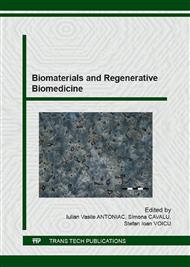[1]
R. Hale, R. Gatti, G. N. Glickman, L. A. Opperman, Comparative analysis of carrier-based obturation and lateral compaction: a retrospective clinical outcomes study, Int J Dent (2012), Article ID 954675.
DOI: 10.1155/2012/954675
Google Scholar
[2]
H. Schilder, Filling root canals in three dimensions. 1967, J Endod, 32 (2006) 281–290.
DOI: 10.1016/j.joen.2006.02.007
Google Scholar
[3]
W.T. Johnson, J. C. Kulild, Obturation of the cleaned and shaped root canal system, in K. M. Hargreaves, S. Cohen, (Eds), Cohen's Pathways of the Pulp, 10th edition, Mosby, St. Louis, Mo, USA, 2010, p.349–351.
DOI: 10.1016/b978-0-323-06489-7.00010-2
Google Scholar
[4]
J.L. Gutmann, D.E. Witherspoon, Obturation of the cleaned and shaped root canal system, In: S. Cohen, R.C. Burns, (Eds), Pathways of the pulp, Eighth ed, Mosby Inc., St Louis, 2002. pp.295-9.
Google Scholar
[5]
G. de Deus, E.D. Gurgel Filho, C.M. Ferreira, T. Coutinho Filho, [Intratubular penetration of root canal sealers], Pesqui Odontol Bras, 16(2002) 332-6.
DOI: 10.1590/s1517-74912002000400009
Google Scholar
[6]
M. Miner, D. Berzins, J. Bahcall, A comparation of thermal properties between guttapercha and a synthetic polymer based root canal filling material(resilon), JOE, 32 (2006).
DOI: 10.1016/j.joen.2006.01.008
Google Scholar
[7]
R. Prakash, V. Gopikrishna, D. Kandaswamy, Gutta-percha – an untold story, Endodontology, 17(2005) 32-36.
DOI: 10.4103/0970-7212.347115
Google Scholar
[8]
G. Tsukada, T. Tanaka, M. Torii, K. Inoue, Shear modulus and thermal properties of gutta percha for root canal filling, J Oral Rehabil , 31(2004) 1139-44.
DOI: 10.1111/j.1365-2842.2004.01349.x
Google Scholar
[9]
Q.D. De Deus, Frequency, location, and direction of the lateral, secondary, and accessory canals, J Endod, 1(1975) 361-6.
DOI: 10.1016/s0099-2399(75)80211-1
Google Scholar
[10]
H. Schilder, A. Goodman, W. Aldrich, The thermomechanical properties of gutta-percha. III. Determination of phase transition temperatures for gutta-percha, Oral Surg Oral Med Oral Pathol, 38(1974) 109-14.
DOI: 10.1016/0030-4220(74)90321-1
Google Scholar
[11]
H. Schilder, A. Goodman, W. Aldrich, The thermomechanical properties of guttapercha. V. Volume changes in bulk gutta-percha as a function of temperature and its relationship to molecular phase transformation, Oral Surg Oral Med Oral Pathol, 59(1985).
DOI: 10.1016/0030-4220(85)90169-0
Google Scholar
[12]
R.N. Weller, W.F. Kimbrough, R.W. Anderson, A comparison of thermoplastic obturation techniques: adaptation to the canal walls, J Endod., 23 (1997) 703-6.
DOI: 10.1016/s0099-2399(97)80406-2
Google Scholar
[13]
E.D. Gurgel-Filho, J.P.A. Feitosa, F.B. Teixeira, R.C. Monteiro de Paula, J.B. Araújo Silva, F.J. Souza Filho, Chemical and x-ray analyses of five brands of dental gutta-percha cone, Int Endod J, 36(2003) 302-7.
DOI: 10.1046/j.1365-2591.2003.00653.x
Google Scholar
[14]
W.R. Moorer, J.M. Genet, Antibacterial activity of gutta-percha cones attributed to the zinc oxide component, Oral Surg Oral Med Oral Pathol, 53(1982) 508-17.
DOI: 10.1016/0030-4220(82)90468-6
Google Scholar
[15]
C.E. Friedman, J.L. Sandrik, M.A. Heuer, G.W. Rapp, Composition and physical properties of gutta-percha endodontic filling materials, J Endod, 3(1977) 304-8.
DOI: 10.1016/s0099-2399(77)80035-6
Google Scholar
[16]
C. Maniglia-Ferreira, G.B. Valverde, J.B. Jr. Silva, R.C. de Paula, J.P. Feitosa, F.J. de Souza-Filho, Clinical relevance of trans 1, 4-polyisoprene aging degradation on the longevity of root canal treatment, Braz Dent J, 18(2007) 97-101.
DOI: 10.1590/s0103-64402007000200002
Google Scholar
[17]
J.J. Mc Cullagh, D.J. Setchell, K. Gulabivala, D.L. Hussey, P. Biagioni, P.J. Lamey et al. A comparison of thermocouple and infrared thermographic analysis of temperature rise on the root surface during the continuous wave of condensation technique, Int Endod J, 33(2000).
DOI: 10.1046/j.1365-2591.2000.00302.x
Google Scholar
[18]
J. Marciano, P.M. Michailesco, Dental gutta-percha: chemical composition, X-ray identification, enthalpic studies, and clinical implications, J Endod, 15(1989) 149-53.
DOI: 10.1016/s0099-2399(89)80251-1
Google Scholar
[19]
K. Gulsahi, Z.C. Cehreli, T. Kuraner, F.T. Dagli, Sealer area associated with cold lateral condensation of gutta-percha and warm coated carrier filling systems in canals prepared with various rotary NiTi systems, Int Endod J, 40(2007) 275-81.
DOI: 10.1111/j.1365-2591.2006.01213.x
Google Scholar
[20]
W.B. Johnson, A new gutta-percha technique, JOE, 4(1978) 184–188.
Google Scholar
[21]
K. Clinton, T. Van Himel, Comparison of a warm Guttapercha obturation technique and lateral condensation, JOE, 27(2001) 692–695.
DOI: 10.1097/00004770-200111000-00010
Google Scholar
[22]
G. Cantatore, W.B. Johnson, The Thermafil system, In: Castellucci A (ed), Endodontics, vol 2, Il Tridente, Firenze, 2007, 702–729.
Google Scholar
[23]
P. Rajeswari, V. Gopikrishna, A. Parameswaran, T. Gupta, D. Kandaswamy, In vitro evaluation of apical micro leakage of Thermafil and Obtura II heated gutta percha in comparison with cold lateral condensation using fluid filtration system, Endodontology, 17(2005).
DOI: 10.4103/0970-7212.347113
Google Scholar
[24]
V. Kytridou, J.L. Gutmann, M.H. Nunn, Adaptation and sealability of two contemporary obturation techniques in the absence of the dentinal smear layer, Int Endod J, 32(1999) 464–474.
DOI: 10.1046/j.1365-2591.1999.00248.x
Google Scholar
[25]
U. Inan, H. Aydemir, T. Taşdemir, Leakage evaluation of three different root canal obturation techniques using electrochemical evaluation and dye penetration evaluation methods, Aust Endod J, 33(2007) 18–22.
DOI: 10.1111/j.1747-4477.2007.00050.x
Google Scholar
[26]
G. De-Deus, E.D. Gurgel-Filho, K.M. Magalhães, T. Coutinho- Filho, A laboratory analysis of gutta-percha-filled area obtained using Thermafil, System B and lateral condensation, Int Endod J, 39(2006) 378–383.
DOI: 10.1111/j.1365-2591.2006.01082.x
Google Scholar
[27]
F.S. Yee, J. Marlin, A.A. Krakow, P. Gron, Three-dimensional obturation of the root canal using injection-molded, thermoplasticized dental gutta-percha, J Endod, 3(1977) 168-74.
DOI: 10.1016/s0099-2399(77)80091-5
Google Scholar


